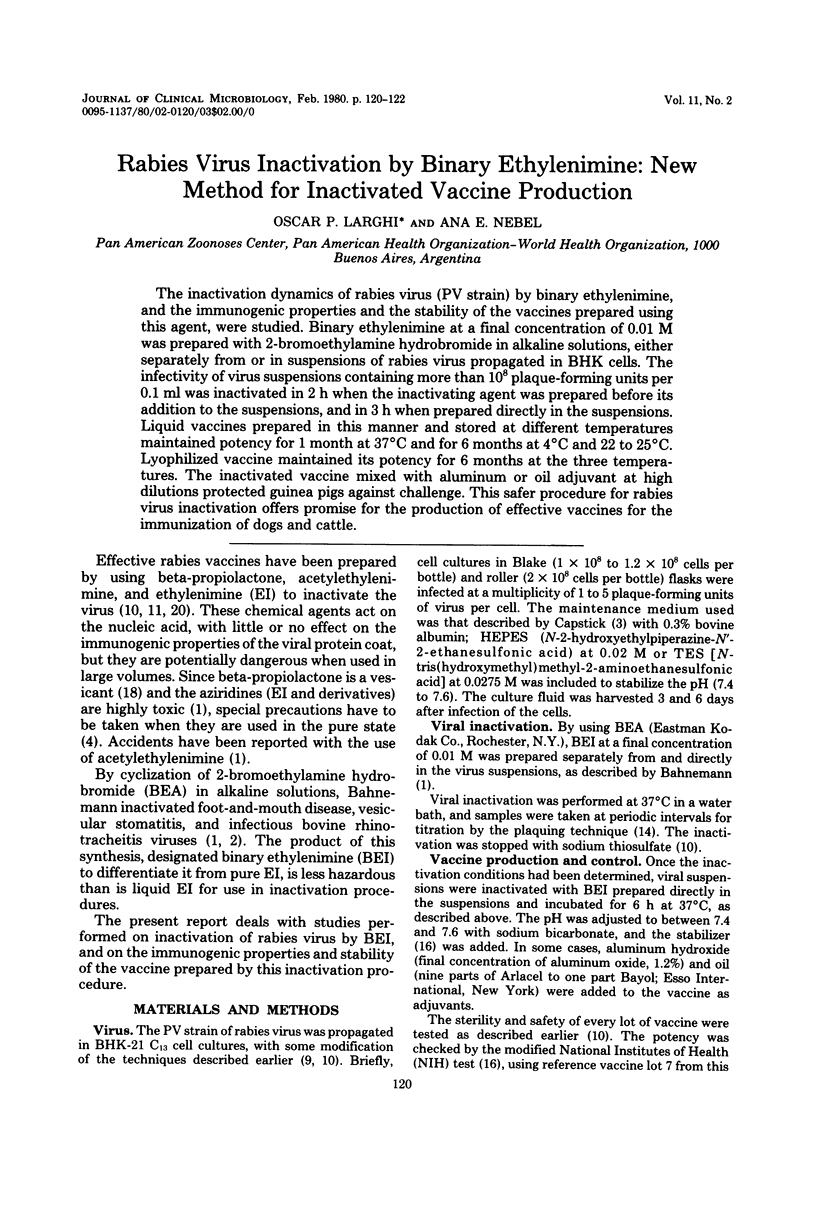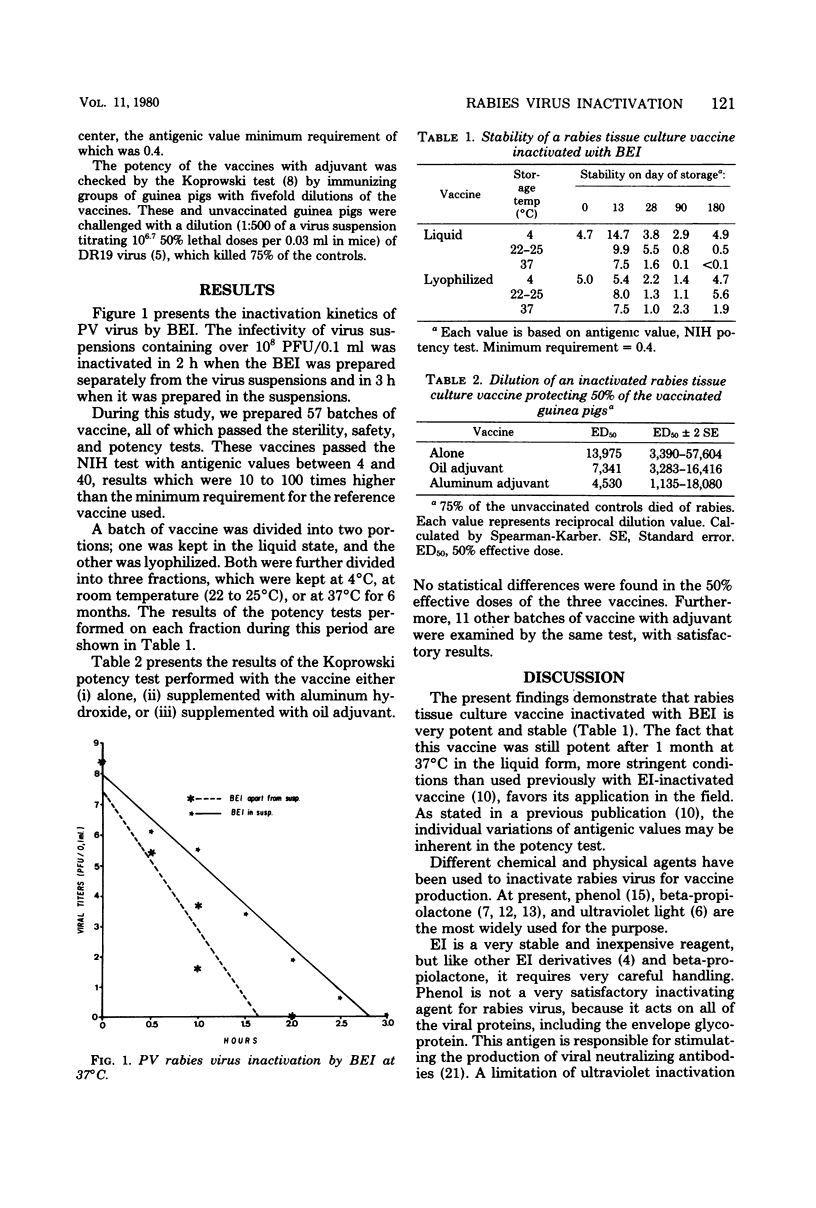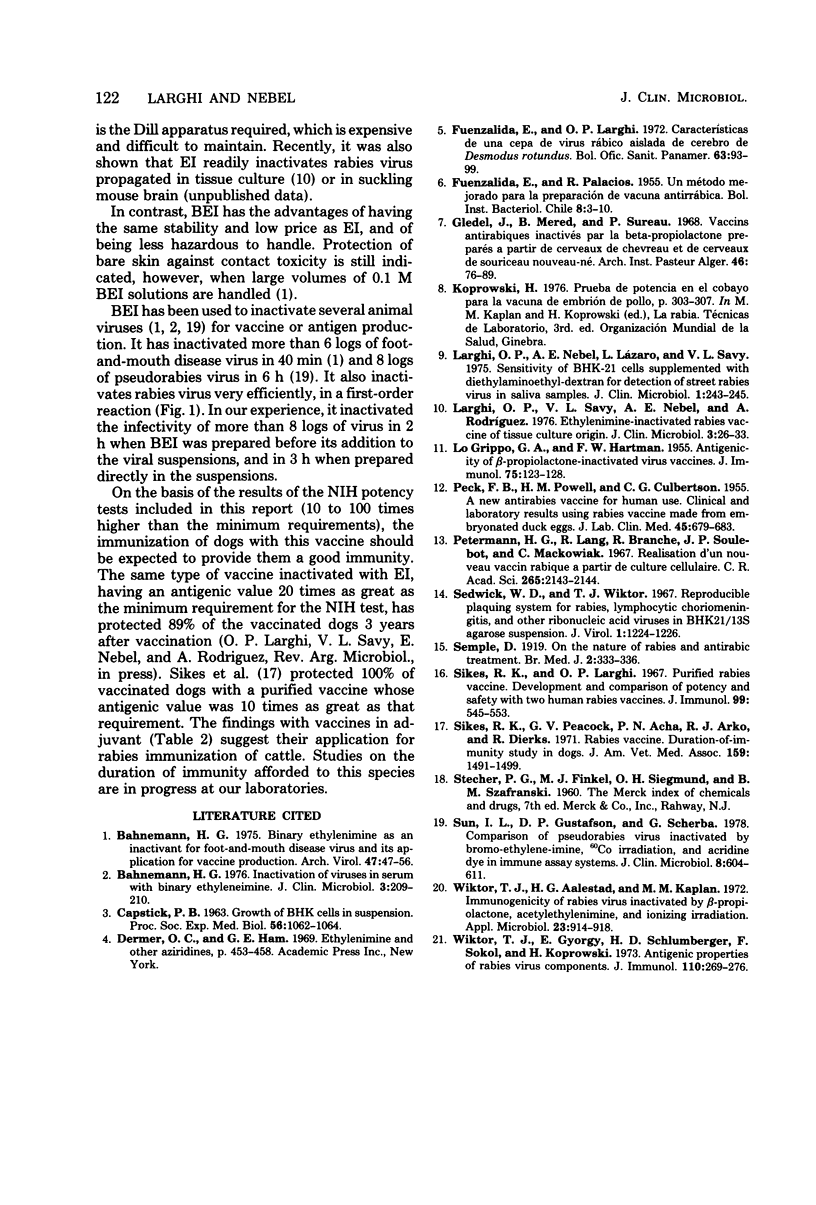Abstract
The inactivation dynamics of rabies virus (PV strain) by binary ethylenimine, and the immunogenic properites and the stability of the vaccines prepared using this agent, were studied. Binary ethylenimine at a final concentration of 0.01 M was prepared wtih 2-bromoethylamine hydrobromide in alkaline solutions, either separately from or in suspensions of rabies virus propagated in BHK cells. The infectivity of virus suspensions containing more than 108 plaque-forming units per 0.1 ml was inactivated in 2 h when the inactivating agent was prepared before its addition to the suspensions, and in3 h when prepared directly in the suspensions. Liquid vaccines prepared in this manner and stored at different temperatures maintained potency for 1 month at 37 degrees C and for 6 months at 4 degrees C and 22 to 25 degrees C. Lyophilized vaccine maintained its potency for 6 months at the three temperatures. The inactivated vaccine mixed with aluminum or oil adjuvant at high dilutions protected guinea pigs against challenge. This safer procedure for rabies virus inactivation offers promise for the production of effective vaccines for the immunization of dogs and cattle.
Full text
PDF


Selected References
These references are in PubMed. This may not be the complete list of references from this article.
- Bahnemann H. G. Binary ethylenimine as an inactivant for foot-and-mouth disease virus and its application for vaccine production. Arch Virol. 1975;47(1):47–56. doi: 10.1007/BF01315592. [DOI] [PubMed] [Google Scholar]
- Bahnemann H. G. Inactivation of viruses in serum with binary ethyleneimine. J Clin Microbiol. 1976 Feb;3(2):209–210. doi: 10.1128/jcm.3.2.209-210.1976. [DOI] [PMC free article] [PubMed] [Google Scholar]
- CAPSTICK P. B. GROWTH OF BABY HAMSTER KIDNEY CELLS IN SUSPENSION. Proc R Soc Med. 1963 Dec;56:1062–1064. doi: 10.1177/003591576305601206. [DOI] [PMC free article] [PubMed] [Google Scholar]
- Fuenzalida D. E., Larghi O. P. Caracteristicas de una cepa de virus rábico aislada del cerebro de Desmodus rotundus. Bol Oficina Sanit Panam. 1972 Aug;73(2):93–99. [PubMed] [Google Scholar]
- LOGRIPPO G. A., HARTMAN F. W. Antigenicity of beta-propiolactone-inactivated virus vaccines. J Immunol. 1955 Aug;75(2):123–128. [PubMed] [Google Scholar]
- Larghi O. P., Nebel A. E., Lazaro L., Savy V. L. Sensitivity of bhk-21 cells supplemented with diethylaminoethyl-dextran for detection of street rabies virus in saliva samples. J Clin Microbiol. 1975 Mar;1(3):243–245. doi: 10.1128/jcm.1.3.243-245.1975. [DOI] [PMC free article] [PubMed] [Google Scholar]
- Larghi O. P., Savy V. L., Nebel A. E., Rodriguez A. Ethylenimine-inactivated rabies vaccine of tissue culture origin. J Clin Microbiol. 1976 Jan;3(1):26–33. doi: 10.1128/jcm.3.1.26-33.1976. [DOI] [PMC free article] [PubMed] [Google Scholar]
- PECK F. B., Jr, POWELL H. M., CULBERTSON C. G. A new antirabies vaccine for human use; clinical and laboratory results using rabies vaccine made from embryonated duck eggs. J Lab Clin Med. 1955 May;45(5):679–683. [PubMed] [Google Scholar]
- Petermann H. G., Lang R., Branche R., Soulebot J. P., Mackowiak C. Réalisation d'un nouveau vaccin rabique à partir de culture cellulaire. C R Acad Sci Hebd Seances Acad Sci D. 1967 Dec 18;265(25):2143–2144. [PubMed] [Google Scholar]
- Sedwick W. D., Wiktor T. J. Reproducible plaquing system for rabies, lymphocytic choriomeningitis,k and other ribonucleic acid viruses in BHK-21-13S agarose suspensions. J Virol. 1967 Dec;1(6):1224–1226. doi: 10.1128/jvi.1.6.1224-1226.1967. [DOI] [PMC free article] [PubMed] [Google Scholar]
- Sikes R. K., Larghi O. P. Purified rabies vaccine: development and comparison of potency and safety with two human rabies vaccines. J Immunol. 1967 Sep;99(3):545–553. [PubMed] [Google Scholar]
- Sikes R. K., Peacock G. V., Acha P., Arko R. J., Dierks R. Rabies vaccines: duration-of-immunity study in dogs. J Am Vet Med Assoc. 1971 Dec 1;159(11):1491–1499. [PubMed] [Google Scholar]
- Sun I. L., Gustafson D. P., Scherba G. Comparison of pseudorabies virus inactivated by bromo-ethylene-imine, 60Co irradiation, and acridine dye in immune assay systems. J Clin Microbiol. 1978 Nov;8(5):604–611. doi: 10.1128/jcm.8.5.604-611.1978. [DOI] [PMC free article] [PubMed] [Google Scholar]
- Wiktor T. J., Aaslestad H. G., Kaplan M. M. Immunogenicity of rabies virus inactivated by -propiolactone, acetylethyleneimine, and ionizing irradiation. Appl Microbiol. 1972 May;23(5):914–918. doi: 10.1128/am.23.5.914-918.1972. [DOI] [PMC free article] [PubMed] [Google Scholar]
- Wiktor T. J., György E., Schlumberger D., Sokol F., Koprowski H. Antigenic properties of rabies virus components. J Immunol. 1973 Jan;110(1):269–276. [PubMed] [Google Scholar]


